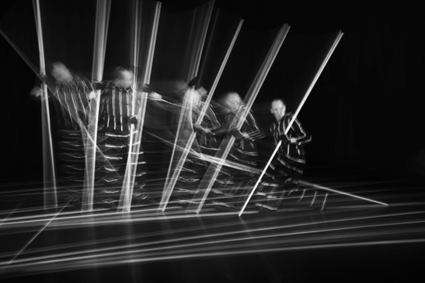a line going for a walk
jonathan marshall: daniel belton’s line dances

Emmett Hardie, Line Dances, Daniel Belton & Good Company
photo WJS Grenfell
Emmett Hardie, Line Dances, Daniel Belton & Good Company
LINE DANCES IS THE LATEST COLLECTION OF SHORT CINEMATIC WORKS FROM NEW ZEALAND CHOREOGRAPHER AND FILMMAKER DANIEL BELTON. AFTER THEIR LAUNCH IN DUNEDIN, BELTON INTENDS TO TOUR THE PIECES. THEY ARE HOWEVER PRINCIPALLY DESIGNED TO BE VIEWED ONLINE.
Belton’s early training as a painter is again evident in these works. He references many of the visual and thematic concerns of his previous films and multimedia dance pieces (RT92)—lines of perspective and sketched trajectories evoking Renaissance illustration, architectural drawings, as well as influences from Russian Constructivism, Futurism and the delicate, minimalistic version of Modernist painting seen in the work of Paul Klee. Belton indeed cites Klee’s lectures at the Bauhaus School of Art during the 1920s as a key influence.
The Bauhaus is known for promoting the notion of colours possessing specific correspondences to each other and to spiritual sensations. With the exception of a few geometric blocks of red recalling the work of Piet Mondrian and the Constructivists, Belton’s Line Dances, though, are largely black and white.
This suits Belton’s purposes well. It gives Line Dances an antique feel consistent with the broadly Modernist visual iconography, as well as establishing a link between these allusions and earlier Baroque and Rococo architectural settings and theatrical modes. The commedia dell’arte Harlequin—or his representation as a figure of ironic playfulness and visual fantasy in Modernist art by Cocteau, Picasso and others—appears, as does a generic, white-attired Columbine ballerina, along with clockwork, automaton-like figures, angular acrobats (looking as if they have stepped out of Meyerhold’s productions) and line drawings of fantastic spaces and buildings with indeterminate, shifting dimensions (shades of Klee’s Room Perspective With Inhabitants, 1921, and The Great Dome, 1927).
Klee’s influence is manifest principally in the work’s conceptualisation. He saw abstract art as based on transparency and opacity, enabling multiple perspectives and viewpoints to be layered to make up a larger, composite picture. Belton either follows suit, or produces similar effects, by dividing the screen into repeating and varying fragments. The reproduction of dancers, figures, motifs, lines and even sounds across the field of perception is a marked feature of Line Dances’ aesthetic.
The onscreen figures are light as paper. Lines of movement or shape are carefully traced across the screen, and then morphed into lyrical smudges. This recurrent theme gives a curious immateriality to the figure. Belton explains in his program notes that he sees the screen as an inherently “artificial” realm, hence his bodies have no weight. They arc, glitch, twitch, curve, multiply and swing, but never thud, hit, crash or stop. The look of the piece, as well as the movement of objects and human shapes, is of constantly evolving insubstantiality.
It is the conditional sketchiness of Belton’s films that provides their central structural conceit, as well as their curiously unresolved ambience. Although often described as a producer of “dance films,” Belton’s relative lack of concern for bodies qua bodies, and his construction of the body as merely one element among a number of parabolic, architectural, painterly and photographic motifs (notably stop-motion photography, as in the work of Anton Bragaglia, Étienne-Jules Marey and its painterly versions by Umberto Boccioni) means that his cinema is perhaps best characterised as moving painting, akin to that of avant-garde filmmakers Ludwig Hirschfeld Mack and Len Lye, whose work Belton’s intermittently evokes.
Klee contended that art should represent a “multiform world…[a] branching and spreading array”—which Belton literally shows in one film, offering an ever diminishing series of budding miniature figures sprouting from rods held at the shoulder of an initial character—and which Klee compares with the “root” and “crown” of a tree. Like Klee, Belton constantly oscillates from one point, outcome or physical position (the crown), through to a root, and then back again. The ideal metaphoric structure for Belton and Klee is therefore the Golden Ratio of mathematician Fibonacci and Cubist theorist Albert Gleizes: the recurrent spiral, such as one sees inside a Nautilus shell. These films never resolve, but microcosmically coil and repeat internally at an ever-reduced scale. Whilst this approach underpins Modernist painting, it is perhaps less effective for the movement in time of the screen space or of the music (which is also simple, repetitive and variational).
The planetoids threading their way backwards and forwards along a white parabola running behind the dancer therefore epitomise this cinematic cycle. Complex and sophisticated though Belton’s films are, they function more as sketches than as final paintings; as a provisional, thoughtful set of lines, or as Klee might say, “a line going for a walk.”
Daniel Belton & Good Company, Line Dances, director, performer, editor Daniel Belton, co-producer, performer Donnine Harrison, piano Anthony Ritchie, Metro Theatre, Otago Festival of the Arts, Dunedin, New Zealand, Oct 10-12; www.goodcompanyarts.com/good-company-arts-line-dances.htm
RealTime issue #100 Dec-Jan 2010 pg. 25






